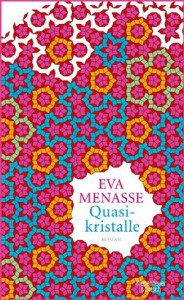The Blog’s Editorial Staff in Discussion (Part II)
Naomi Lubrich: We recently talked together about Eva Menasse’s novel Quasicrystals but we haven’t decided which of us will write a review of the book for our blog. Personally I would be interested in doing it, and I have something to say not only about the Jewish theme but also about Menasse’s image of women, that I found to be unrealistically and ideationally drawn. Xane is a downright caricature of a “high-powered woman”: a caring mother and stepmother of three children with, to some extent, behavioral problems. And at the same time she’s a leading film artist and influential intellectual. On top of all this she has a harmonious, uncomplicated marriage, and she even gets involved with a number of other men…
Mirjam Bitter: I also thought the idealization of Manasse’s heroine was a shame, especially as the novel went on. In the first chapters, the description of the main character alternates between mediocrity and mystification. It also becomes clear that statements about her are colored by whichever of the characters’ perspective the chapter was written from. But the further the text progresses, the less it fulfills the potential of its title and structure. Rather than a quasicrystal with an apparently random structure, it presents an ever clearer – crystal clear – and more idealized picture of Xane. The different narrators weigh in on Xane’s life with a variety of appraisals, of course, but those who see her negatively reveal themselves above all: the step-daughter as a pubescent monster, Xane’s employee as a man suffering primarily from hubris, and Krystyna as a resentful friend withholding help.
I also found it a pity that Xane herself suddenly narrates in the seventh chapter. It would have been more convincing to have to figure out the character entirely from the perspectives of those around her. Yet perhaps the first-person perspective was necessary in order to deal with the subject of postpartum depression and a female mid-life crisis? Perhaps the idealizing character depiction was in fact a way to take up the issue of miscarriages without having the book become maudlin? Whether it’s ideal to pick up a guy again at her age but to be at odds with her best friend, however, remains questionable.
 Mirjam Wenzel: I don’t share your critical view that the character is unrealistically conceived or depicted as an ideal. I believe that this impression is created by the novel’s constitution, by the different perspectives through which the main character comes into view. Since these perspectives are based throughout – as the metaphor of the mirror underlines – on voyeuristic attributions and projections. That Xane herself begins to speak after the unsuccessful love affair – anticipating on her part the success of her friend’s love affair – presents a break in the constitution of the novel. This in turn points exactly to this nexus of narration, projection, and desire. It is just this triad by which the novel draws a line from the first to the last love and holds each chapter together at heart.
Mirjam Wenzel: I don’t share your critical view that the character is unrealistically conceived or depicted as an ideal. I believe that this impression is created by the novel’s constitution, by the different perspectives through which the main character comes into view. Since these perspectives are based throughout – as the metaphor of the mirror underlines – on voyeuristic attributions and projections. That Xane herself begins to speak after the unsuccessful love affair – anticipating on her part the success of her friend’s love affair – presents a break in the constitution of the novel. This in turn points exactly to this nexus of narration, projection, and desire. It is just this triad by which the novel draws a line from the first to the last love and holds each chapter together at heart.
As for our review: how about simply writing down and publishing our talk on the blog? With some luck our readers will continue the discussion in the comments section.
Eva Menasse, Quasikristalle, Cologne: Kiepenheuer & Witsch 2013.
